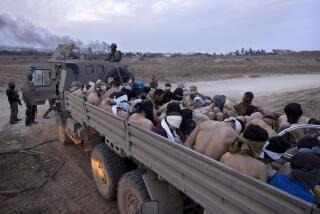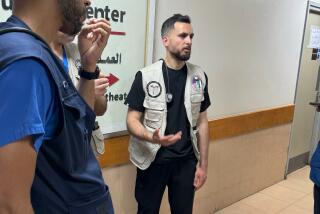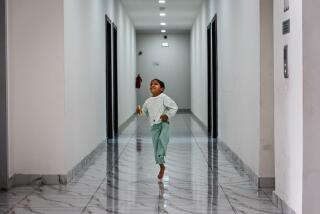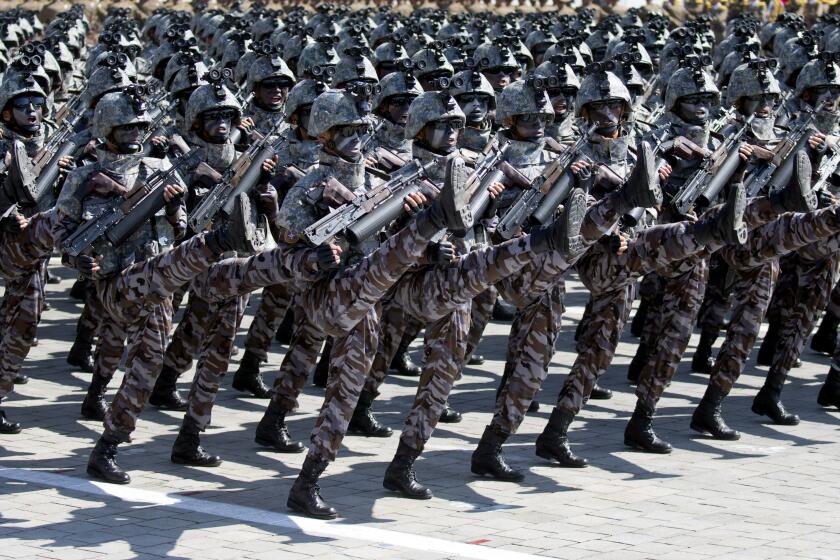Hospital’s Quake Victims Stay Put
BANTUL, Indonesia — Panembahan Senopati Hospital was designed for 140 patients. On Monday, it had 1,200.
Even so, the wards were nearly empty. No one wanted to stay inside. Instead, the patients lay in rows in the open-air reception area and in the sprawling hospital’s exterior corridors.
These were survivors of Saturday’s earthquake, which measured 6.3 in magnitude and had killed 5,427 people as of today. Many at the hospital Monday had casts on broken limbs and bandages on cuts, but the psychic wounds they suffered from the quake may be far greater.
“The main problem is the patients don’t want to go home,” said the hospital’s director, Dr. Endang Purwati. “They are afraid to go and they don’t have houses.”
Most of the patients narrowly escaped from their collapsing homes and live in fear of a major aftershock. Refusing to stay in the wards, they appeared poised to make a break for the parking lot at the first sign of shaking.
They lay on mattresses, thin woven mats or pieces of cardboard. Some were connected to intravenous drips that hung from window frames and exterior air-conditioning units.
Even those who were sedated or wearing casts were resting in prime spots only a few steps from the safety of the open air. Never mind that the sturdily built hospital suffered no damage Saturday.
“If there is another earthquake, we can run faster,” said Nada Refty Nurhidayah, 15, who was taking care of Ngatrihardi Suwarno, her grandmother.
Suwarno suffered a compressed vertebra when two banana trees fell on her. Sedated, she lay on a mat on the floor two feet from the main reception counter, surrounded by hundreds of other patients. Soldiers carried injured people past on cots, and the area was filled with the constant buzz of activity.
People came every few minutes to stand only inches from Suwarno’s head and use a phone on the counter. Some narrowly missed stepping on her. She was oblivious.
Authorities estimate that the quake left 100,000 to 200,000 Indonesians homeless in the central part of Java island. Many are sleeping in rice paddies and soccer fields in shelters made of plastic sheeting, which do little to protect them from the frequent downpours.
Throughout the quake zone Monday, hundreds of young men and boys stood in the middle of busy streets with cardboard boxes, begging for assistance from cars that zipped past. “We need to eat,” read the sign on a box held by one boy. “Please help,” said another.
In the stricken village of Manding Gandekan, about 50 villagers were taking part in a fundraising drive. Some had placed chairs and benches in the middle of the street to slow traffic. Sometimes, one of the boys would step in front of a line of cars to stop them in the hope of snagging a donation.
“Nobody’s scared, because this is what we do to get some food,” said Rustam Nurkholis, 18. In three days of begging, he said, the group had raised about $18.
President Susilo Bambang Yudhoyono acknowledged Monday that assistance had been slow in arriving to the quake zone. “I saw in many areas that there are things that need to be speeded up,” he said.
Idham Samawi, the regent of Bantul, the hardest-hit area, said he was sorry the government had not done more to help.
“We apologize to Bantul residents for not being able to help optimally for the past two days,” he said. “But now we have enough people to work.”
Nearly 100 troops from Malaysia joined Indonesian soldiers and volunteers in digging through the rubble for bodies. Authorities said Monday that three days after the quake, finding survivors was unlikely.
Archeologists were still coming to grips with the damage caused to Prambanan, a 9th century Hindu temple complex that is one of Indonesia’s most significant historical monuments. The tallest temple rises more than 150 feet.
Hundreds of chunks of stone were shaken loose from the complex’s 16 main temples. Many of them weigh hundreds of pounds each and crashed to the ground. Some of the intricate stone reliefs were damaged, and one of the temples has begun leaning to one side.
To help treat survivors, meanwhile, the United States was sending 100 doctors and other medical personnel from facilities in Okinawa, Japan; Guam; and the Philippines.
Purwati, the hospital director, welcomed the possibility of assistance. She said her facility was in need of doctors and nurses, surgical equipment, and needles and thread for sewing up wounds.
She said most of the patients admitted to the hospital had broken bones and cuts. She estimated that one-third of those were physically healthy enough to leave.
Suprapdi Harjono, 54, was in the hospital for kidney failure when the earthquake struck. Like other patients, he hurried out onto the lawn. The shock of the quake gave him a mild heart attack. On Monday, he sat quietly on a mattress in an outer corridor with other patients.
“We ran when the earthquake happened,” he said. “Now I am scared to go back to my room.”
More to Read
Sign up for Essential California
The most important California stories and recommendations in your inbox every morning.
You may occasionally receive promotional content from the Los Angeles Times.










